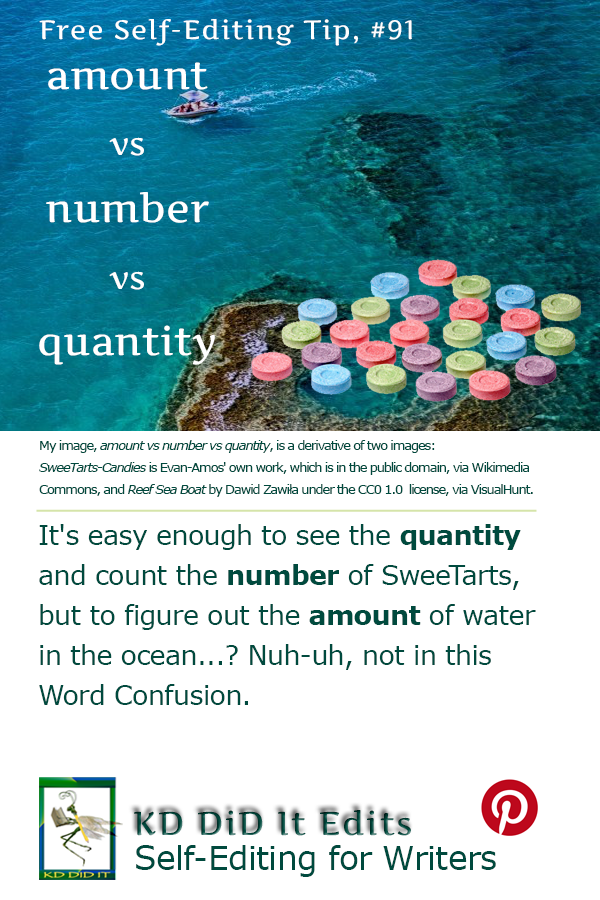Revised as of
20 June 2023
I ran across quantity as a word confusion with number and amount, and as it is quite similar to number, I decided to include it with this already published post on Amount vs Number.
In a quick synopsis:
- Amount is used with singular nouns that represent uncountable nouns, i.e., grains of sand on the beach, how much air is in the atmosphere, how much water is in the ocean, etc.
- Number counts up what can be counted, i.e., how many cans of Coke are left in the fridge, how many pieces of pie are left, the number of cars in the driveway, etc.
- Quantity also counts what can be counted, but does so in a measured way.
“Amount versus Number” originally came up when I ran across a sheet from one of my prerequisite English classes — in college!! — which listed “Confusing Word Pairs” and amount versus number was one of the pairs listed. I find them confusing myself, so I’m looking forward to having an easy reference on amount and number in the future. And now…quantity.
| Stressing the Difference Between Amount, Number, and Quantity | ||
|---|---|---|
| Amount | Number | Quantity |
| How much have you had to drink tonight?
Oh, a fair amount. The drinker has not been counting. |
The number of logs used to build this house was astonishing.
You really can count how many logs were used. |
The ship was only carrying a large quantity of mangoes.
Mangoes are plural and countable. |
Exploring Later . . .
You may be curious about other “number” issues. For example, for information on formatting numbers, see “Abbreviation“, using numbers with street addresses, “Numnerals“, “comparing numbers, dealing with numbers that are side by side.
When and how to approximate or round numbers as well as formatting time and when to spell out numbers. Numbers and the percent symbol, %. When you must spell out a number or use Arabic figures or pluralizing an Arabic figure.
Regarding the grammar of numbers, see “Cardinal numbers“.
As a group or collective noun, pluralizing a number that is written out or the figure.
Commas and numbers as well as the proper use of the en dash and numbers. There’s a proper use of the hyphen for compound numbers, used in relation to age, with a prefix, and when to use a hyphen to separate numbers. Then there’s using a slash with numbers.
Word Confusions . . .
. . . started as my way of dealing with a professional frustration with properly spelled words that were out of context in manuscripts I was editing as well as books I was reviewing. It evolved into a sharing of information with y’all. I’m hoping you’ll share with us words that have been a bête noire for you from either end.
If you found this post on “Amount vs Number vs Quantity” interesting, consider subscribing to KD Did It, if you’d like to track this post for future updates.
| Amount | Number | Quantity |
|---|---|---|

An Area of Leon, Wisconsin, Shows Flooding, 28 August 2018, is under the Public Domain Mark 1.0 license, via NARA & DVIDS Public Domain Archive. — Any amount of water can cause flooding. |
I know, it’s dull. But it does get the point about numbers across . . . |

Thermometer for Degree Fahrenheit and Celsius Marc-Lautenbacher is under the CC BY-SA 4.0 license, via Wikimedia Commons. — Temperature and time are both measurable quantities. |
| Part of Grammar: | ||
| Noun 1; Verb, intransitive 2 Plural for the noun: amounts Third person present verb: amounts |
Noun 1; Verb 2, intransitive & transitive Plural for the noun: numbers Third person present verb: numbers |
Noun
Plural: quantities |
| Can’t be counted
Noun: A quantity of something, typically the total of a thing or things in number, size, value, or extent
Verb, intransitive: Come to be the total when added together
|
A symbol or word indicating how many and can be counted
Noun: An arithmetical value, expressed by a word, symbol, or figure, representing a particular quantity and used in counting and making calculations and for showing order in a series or for identification
A quantity or amount
A single issue of a magazine
[Grammar] A distinction of word form denoting reference to one person or thing or to more than one Verb, intransitive:
To be numbered or included (usually followed by among or with) To count Verb, transitive: Comprise
Mark with a number or assign a number to, typically to indicate position in a series
See the rule on how number can be a singular or plural noun. |
The ability to measure the amount or number of things
The amount or number of a material or immaterial thing not usually estimated by spatial measurement
[Phonetics] The perceived length of a vowel sound or syllable [Mathematics & Physics] A value or component that may be expressed in numbers
|
| Examples: | ||
| Noun: He ate a fair amount of roast beef. A good marriage can withstand any amount of pressure. No amount of pressure can be brought to bear We sold a comparable amount in the second quarter. The sport gives an enormous amount of pleasure to many people. The substance is harmless if taken in small amounts. They have spent a colossal amount rebuilding the stadium. Verb, intransitive: Their actions amounted to a conspiracy. What this guy was doing clearly did amount to persecution. You’ll never amount to anything. |
Noun: She dialed the number carefully. I prefer an even number. The boy was adept at numbers. The company is seeking to increase the number of women on its staff. The exhibition attracted vast numbers of visitors. We have discussed the matter on a number of occasions. There were some distinguished names among our number. The weight of numbers turned the battle against them. the October number of Travel They go from one melodious number to another. Yvonne was wearing a little black number. Whole numbers are easier to add up. We’ve had a large number of complaints. Jane and Mike went to the wedding of one of their number The band performed another number. Verb, intransitive: Several eminent scientists number among his friends. Number the new stock, please. Verb, transitive: He numbers the fleet at a thousand. Each paragraph is numbered. He numbers her among his friends. His days are numbered. The orchestra numbers Brahms among its past conductors. Each document was numbered consecutively. Strategies like ours can be numbered on the fingers of one hand. |
The quantity and quality of the fruit can be controlled.
Note down the sizes, colors, and quantities that you require. It was not a small quantity of food. If taken in large quantities, the drug can result in liver failure. She was able to drink quantities of beer without degenerating into giggles. Many people like to buy in quantity. In syllables, quantity is measured from the beginning of the vowel or diphthong to the end of the syllable. Phrases like “a number” or “the number” tell us our expression has an unknown quantity, called a variable. The state of a physical system depends on measurable quantities such as the pressure, the temperature, the spatial position, etc. |
| History of the Word: | ||
|
|
Middle English from the Old French quantite, which is from the Latin quantitas (translating the Greek posotēs), from quantus meaning how great, how much. |
C’mon, get it out of your system, bitch, whine, moan . . . which words are your pet peeves? Also, please note that I try to be as accurate as I can, but mistakes happen or I miss something. Email me if you find errors, so I can fix them . . . and we’ll all benefit!
Satisfy your curiosity about other Word Confusions on its homepage or more generally explore the index of self-editing posts. You may also want to explore Book Layout & Formatting Ideas, Formatting Tips, Grammar Explanations, Linguistics, Publishing Tips, the Properly Punctuated, Writing Ideas and Resources, and Working Your Website.
Resources for Amount vs Number vs Quantity
Apple Dictionary.com
Pinterest Photo Credits
Both images are in the public domain: SweeTarts-Candies is Evan-Amos’ own work from which the background was removed in Photoshop, via Wikimedia Commons, and Reef Sea Boat by Dawid Zawiła is via VisualHunt.



This was a great example of word confusion that we often would not acknowledge .
I must admit it’s not one that I’ve paid much attention to before—these word confusions sometimes help ME a lot! I think it’s been more instinctive on my part as I seem to retain so much of what I read—and I’ve been reading for donkey’s years, LOL!